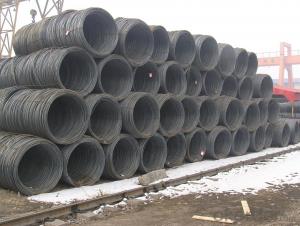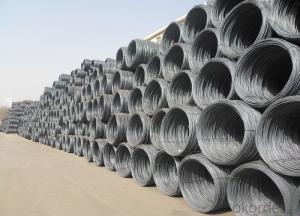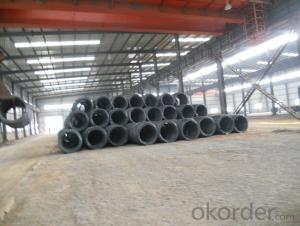Prime Hot Rolled Steel Wire Rod in Coils
- Loading Port:
- China main port
- Payment Terms:
- TT OR LC
- Min Order Qty:
- 100 m.t.
- Supply Capability:
- 10000 m.t./month
OKorder Service Pledge
OKorder Financial Service
You Might Also Like
Item specifice
Product Description:
OKorder is offering Prime Hot Rolled Steel Wire Rod in Coils at great prices with worldwide shipping. Our supplier is a world-class manufacturer of steel, with our products utilized the world over. OKorder annually supplies products to African, South American and Asian markets. We provide quotations within 24 hours of receiving an inquiry and guarantee competitive prices.
Product Applications:
Prime Hot Rolled Steel Wire Rod in Coils are ideal for structural applications and are widely used in construction and manufacturing. Carbon steel wire rod is mainly used for reinforcement of reinforced concrete and welded structure or reprocessed (roberts , nail, etc.) materials, especially used to produce wire drawing, welding electrode, nails, spring, electronic, precise machinery parts and so on.
Product Advantages:
OKorder's Prime Hot Rolled Steel Wire Rod in Coils are durable, strong, and wide variety of sizes.
Main Product Features:
· Premium quality
· Prompt delivery & seaworthy packing (30 days after receiving deposit)
· Can be recycled and reused
· Mill test certification
· Professional Service
· Competitive pricing
Product Specifications:
Manufacture: Hot rolled
Grade: HRB400,HRB400E,HRB500
Certificates: ISO, SGS, BV, CIQ
Packaging: Export packing, nude packing, in coils, each coil around 2mt
Size: 5.5mm, 6.5mm, 8mm, 10mm
Chemical composition (%): | C | Si | Mn | P | S | Ceq | |||
HRB335 HRBF335 |
0.25 |
0.80 |
1.60 |
0.045 |
0.045 | 0.52 | |||
HRB400 HRBF400 | 0.54 | ||||||||
HRB500 HRBF500 | 0.55 | ||||||||
Mechanical properties | Steel | Rel/ MPa | Rm/ MPa | A/ % | Agt/ % | ||||
≥ | |||||||||
HRB335 HRBF335 | 335 | 455 | 17 |
7.5 | |||||
HRB400 HRBF400 | 400 | 540 | 16 | ||||||
HRB500 HRBF500 | 500 | 630 | 15 | ||||||
FAQ:
Q1: Why buy Materials & Equipment from OKorder.com?
A1: All products offered byOKorder.com are carefully selected from China's most reliable manufacturing enterprises. Through its ISO certifications, OKorder.com adheres to the highest standards and a commitment to supply chain safety and customer satisfaction.
Q2: How do we guarantee the quality of our products?
A2: We have established an advanced quality management system which conducts strict quality tests at every step, from raw materials to the final product. At the same time, we provide extensive follow-up service assurances as required.
Q3: How soon can we receive the product after purchase?
A3: Within three days of placing an order, we will arrange production. The normal sizes with the normal grade can be produced within one month. The specific shipping date is dependent upon international and government factors, the delivery to international main port about 45-60days.
Images:
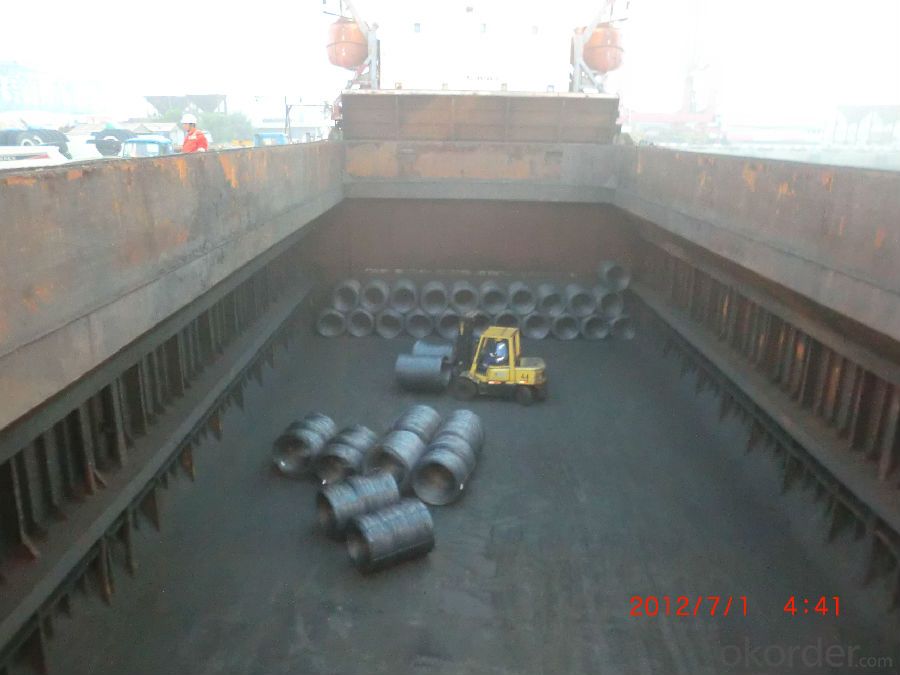


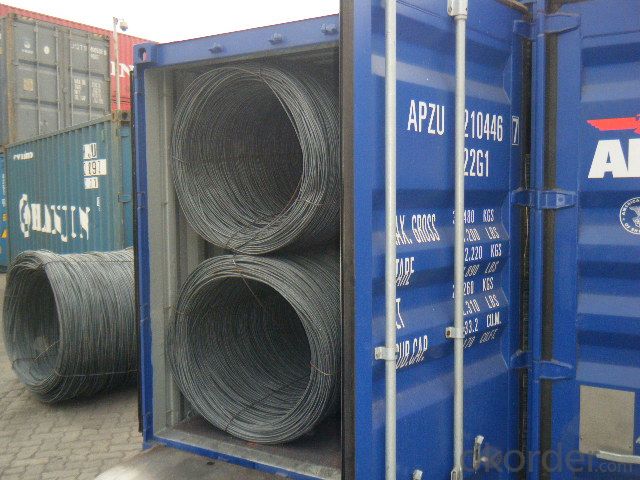
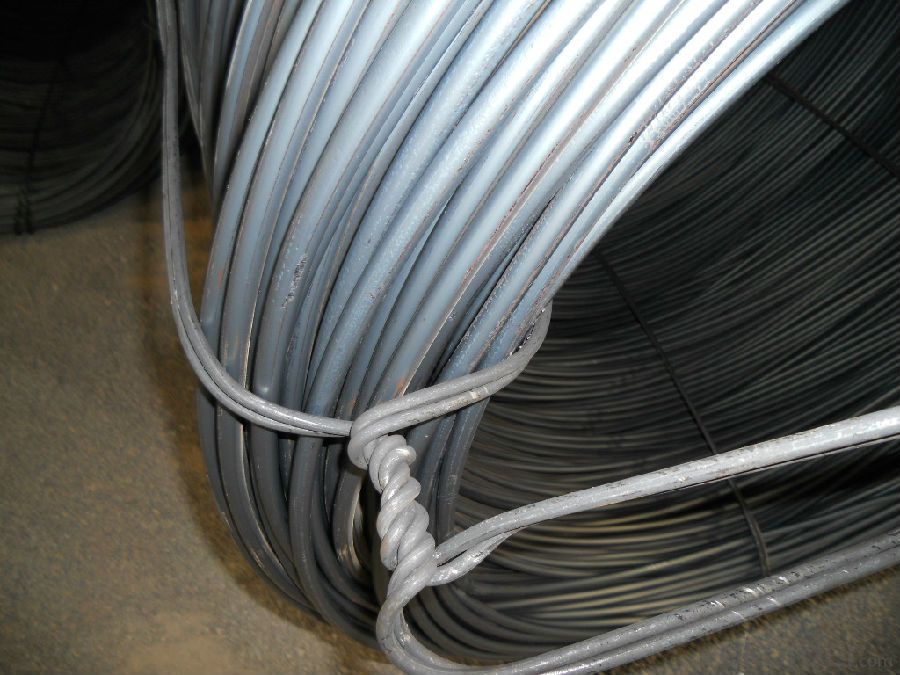
- Q:What are the different production processes involved in steel wire rod manufacturing?
- The different production processes involved in steel wire rod manufacturing include raw material preparation, melting and refining, casting, hot rolling, cooling, and finishing.
- Q:How are steel wire rods used in the production of barbed wire?
- Barbed wire relies heavily on steel wire rods, which are essential for its production. These rods undergo a transformation process to become the sharp and enduring barbs that adorn the wire. To achieve this, the rods are subjected to a series of machines that shape them into a twisted pattern, with evenly spaced barbs along its length. To ensure the effectiveness of the final product, the steel wire rods used in barbed wire production must possess specific properties. They must be robust, as barbed wire is commonly used for fencing and security purposes. Additionally, the rods need to be flexible enough to be molded into the desired shape without any breakage or loss of integrity. This becomes particularly important during installation, as the wire is often stretched. Any weakness or brittleness in the steel rods could result in the wire breaking or becoming less efficient as a security measure. Once the steel wire rods have been shaped accordingly, they are typically galvanized to enhance their durability and resistance to corrosion. This involves applying a protective layer of zinc onto the wire's surface, preventing rusting and extending the lifespan of the barbed wire. In conclusion, steel wire rods play a fundamental role in the production of barbed wire. They provide the necessary strength, flexibility, and durability to create effective fencing and security solutions. Without these rods, the production of barbed wire would be impossible, significantly impacting its various applications, from agricultural use to perimeter security.
- Q:How is steel wire rod used in the manufacturing of wire forms for communication cables?
- Steel wire rod plays a vital role in the manufacturing process of wire forms for communication cables. It serves as the foundational material from which wires are derived. Once obtained, the steel wire rod goes through a sequence of procedures to transform it into wire forms suitable for communication cables. To begin with, the steel wire rod is thoroughly cleansed and inspected to identify any defects or impurities. This guarantees that the resulting wire forms meet the required standards and are of the utmost quality. Once cleansed, the steel wire rod is heated to a specific temperature and passed through a set of dies. This process, referred to as drawing, reduces the diameter of the wire rod while increasing its length. Subsequent to the drawing process, the steel wire rod undergoes further processing to enhance its mechanical properties. This may involve annealing, a heat treatment method that enhances the wire's flexibility and reduces its brittleness. Additionally, the wire may undergo various surface treatments to augment its resistance to corrosion or provide insulation. Once the wire forms are manufactured, they are utilized in the production of communication cables. These wire forms can function as conductive elements within the cables, enabling the transmission of electrical signals. Moreover, the wire forms can be utilized as structural components, imparting strength and support to the cables. In the manufacturing of communication cables, the steel wire rod guarantees the production of high-quality wire forms that meet the specific requirements of these cables. The durability, flexibility, and conductivity of the wire forms contribute to the efficient and reliable transmission of information through the communication cables.
- Q:What are the different sizes and dimensions of steel wire rod?
- Steel wire rods come in various sizes and dimensions, typically ranging from 5.5mm to 14mm in diameter. The length can vary, but commonly it is around 6 to 12 meters. These dimensions can be adjusted based on specific requirements and applications.
- Q:What are the common forming techniques used for steel wire rod?
- The common forming techniques used for steel wire rod include drawing, rolling, and extrusion.
- Q:How is steel wire rod used in the manufacturing of wire forms for jewelry findings?
- Steel wire rod serves as a crucial element in the creation of wire forms for jewelry findings. It acts as the primary raw material that can be shaped and sized into different wire forms. The initial step in utilizing steel wire rod for jewelry findings involves determining the desired diameter and length of the wire. This is a crucial factor as it determines the strength and flexibility of the final product. Once the specifications are established, the steel wire rod is divided into smaller sections, which are then straightened and polished. After the initial preparation, the wire rod is molded and manipulated using specialized tools and techniques. For instance, it can be bent, twisted, or coiled to form various wire forms like jump rings, ear wires, clasps, and connectors. These wire forms play an essential role in holding jewelry pieces together. Using steel wire rod in the manufacturing process of wire forms for jewelry findings offers numerous benefits. Firstly, steel is a durable and robust material, providing strength and stability to the end product. This ensures that the wire forms can endure everyday wear and tear. Additionally, steel wire rod is resistant to corrosion, making it suitable for creating long-lasting jewelry pieces. Furthermore, steel wire rod allows for a wide range of design possibilities. It is highly malleable and can be easily shaped into intricate patterns and designs, adding aesthetic appeal to the jewelry findings. The versatility of steel wire rod enables jewelry designers to create unique and personalized wire forms that cater to individual preferences. In conclusion, steel wire rod is an indispensable component in the production of wire forms for jewelry findings. Its strength, durability, resistance to corrosion, and malleability make it an ideal material for crafting various wire forms like jump rings, ear wires, clasps, and connectors. By utilizing steel wire rod, jewelry manufacturers can create high-quality and visually pleasing jewelry findings that enhance the overall design and functionality of jewelry pieces.
- Q:What are the different types of electrical cables made from steel wire rod?
- There are several different types of electrical cables that are made from steel wire rod. One common type is steel wire armored (SWA) cable, which is used for underground and outdoor installations. It consists of a steel wire armor layer that provides mechanical protection to the cable and allows it to withstand external stresses. Another type is steel tape armored (STA) cable, which also provides mechanical protection but uses a steel tape instead of a wire armor layer. This type of cable is often used in high voltage and industrial applications where extra protection is required. Steel wire braided (SWB) cable is another variation, which features a braided steel wire layer around the insulation. This design provides additional flexibility and resistance to external damage. Furthermore, steel wire reinforced (SWR) cable is used in applications where high tensile strength is required. It consists of a steel wire reinforcement layer that enhances the cable's ability to withstand pulling forces. Lastly, steel wire composite (SWC) cable is a type of cable that combines steel wire with other materials such as aluminum or copper. This combination allows for improved electrical conductivity while still maintaining the mechanical strength provided by the steel wire. Overall, these different types of electrical cables made from steel wire rod offer varying levels of mechanical protection, flexibility, and tensile strength, allowing for their use in a wide range of applications.
- Q:How is steel wire rod packaged for transportation and storage?
- Steel wire rod is typically packaged for transportation and storage in coils or bundles. The wire rod is wound into large coils, which are then secured with steel straps or wires. Alternatively, smaller bundles may be created by grouping several rods together and wrapping them with plastic or steel straps. This packaging ensures ease of handling, prevents damage during transit, and allows for efficient storage in warehouses or yards.
- Q:What are the corrosion resistance requirements for steel wire rod used in marine wire ropes?
- The corrosion resistance requirements for steel wire rod used in marine wire ropes are typically very high. The wire rod needs to be able to withstand the harsh and corrosive environments found in marine settings, including exposure to saltwater and other corrosive elements. It is important for the wire rod to have a protective coating or be made from a corrosion-resistant material such as stainless steel to ensure longevity and durability in these conditions.
- Q:What are the common raw materials used in steel wire rod production?
- The primary raw materials utilized in the production of steel wire rods are iron ore, coal, and limestone. Steel production heavily relies on iron ore, which is acquired through mining. Coal is utilized as a fuel during the steelmaking process to generate the necessary heat and energy. Limestone is introduced into the steelmaking process as a fluxing agent, aiding in impurity removal and slag formation. Furthermore, different alloying elements like chromium, nickel, and manganese may be incorporated into the steel to attain desired properties. These raw materials play a critical role in manufacturing top-notch steel wire rods that find extensive applications in industries such as construction, automotive, and manufacturing.
1. Manufacturer Overview |
|
|---|---|
| Location | |
| Year Established | |
| Annual Output Value | |
| Main Markets | |
| Company Certifications | |
2. Manufacturer Certificates |
|
|---|---|
| a) Certification Name | |
| Range | |
| Reference | |
| Validity Period | |
3. Manufacturer Capability |
|
|---|---|
| a)Trade Capacity | |
| Nearest Port | |
| Export Percentage | |
| No.of Employees in Trade Department | |
| Language Spoken: | |
| b)Factory Information | |
| Factory Size: | |
| No. of Production Lines | |
| Contract Manufacturing | |
| Product Price Range | |
Send your message to us
Prime Hot Rolled Steel Wire Rod in Coils
- Loading Port:
- China main port
- Payment Terms:
- TT OR LC
- Min Order Qty:
- 100 m.t.
- Supply Capability:
- 10000 m.t./month
OKorder Service Pledge
OKorder Financial Service
Similar products
New products
Hot products
Related keywords
